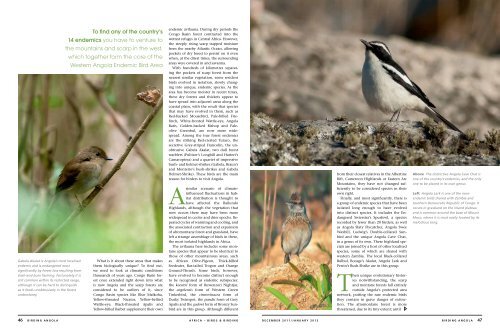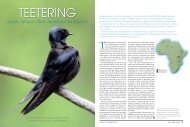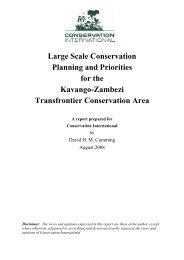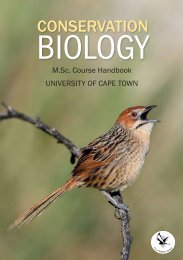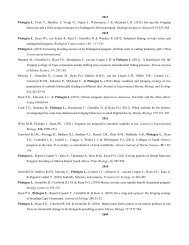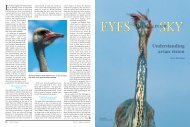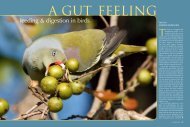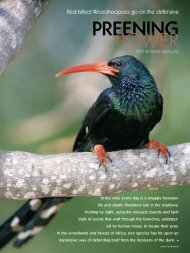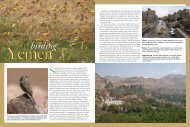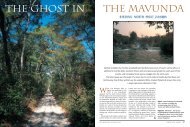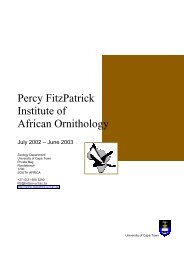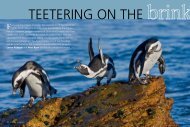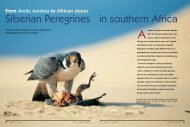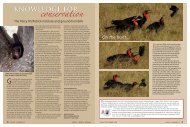Birding Angola - Percy FitzPatrick Institute of African Ornithology
Birding Angola - Percy FitzPatrick Institute of African Ornithology
Birding Angola - Percy FitzPatrick Institute of African Ornithology
Create successful ePaper yourself
Turn your PDF publications into a flip-book with our unique Google optimized e-Paper software.
Gabela Akalat is <strong>Angola</strong>’s most localisedendemic and is endangered mostsignificantly by forest loss resulting fromslash-and-burn farming. Fortunately it isstill common within its restricted range,although it can be hard to distinguishas it feeds unobtrusively in the forestunderstorey.To find any <strong>of</strong> the country’s14 endemics you have to venture tothe mountains and scarp in the west,which together form the core <strong>of</strong> theWestern <strong>Angola</strong> Endemic Bird AreaWhat is it about these areas that makesthem biologically unique? To find out,we need to look at climatic conditionsthousands <strong>of</strong> years ago. Congo Basin forestonce extended right down into whatis now <strong>Angola</strong> and the scarp forests areconsidered to be outliers <strong>of</strong> it, sinceCongo Basin species like Blue Malkoha,Yellow-throated Nicator, Yellow-belliedWattle-eye, Black-throated Apalis andYellow-billed Barbet supplement their ownendemic avifauna. During dry periods theCongo Basin forest contracted into thewettest refuges in Central Africa. However,the steeply rising scarp trapped moisturefrom the nearby Atlantic Ocean, allowingpockets <strong>of</strong> dry forest to persist on it evenwhen, at the driest times, the surroundingareas were covered in arid savanna.With hundreds <strong>of</strong> kilometres separatingthe pockets <strong>of</strong> scarp forest from thenearest similar vegetation, some residentbirds evolved in isolation, slowly changinginto unique, endemic species. As thearea has become moister in recent times,these dry forests and thickets appear tohave spread into adjacent areas along thecoastal plain, with the result that speciesthat may have evolved in them, such asRed-backed Mousebird, Pale-billed Firefinch,White-fronted Wattle-eye, <strong>Angola</strong>Batis, Golden-backed Bishop and PaleoliveGreenbul, are now more widespread.Among the true forest endemicsare the striking Red-crested Turaco, thesecretive Grey-striped Francolin, the unobtrusiveGabela Akalat, two dull forestwarblers (Pulitzer’s Longbill and Hartert’sCamaroptera) and a quartet <strong>of</strong> impressivebush- and helmet-shrikes (Gabela, Braun’sand Monteiro’s bush-shrikes and GabelaHelmet-Shrike). These birds are the mainreason for birders to visit <strong>Angola</strong>.Asimilar scenario <strong>of</strong> climateinfluencedfluctuations in habitat distribution is thought tohave affected the BailundoHighlands, although the vegetation thatnow occurs there may have been morewidespread in cooler and drier epochs. Repeatedcycles <strong>of</strong> warming and cooling, andthe associated contraction and expansion<strong>of</strong> afromontane forest and grassland, haveleft a strange assemblage <strong>of</strong> birds in these,the most isolated highlands in Africa.The avifauna here includes some montanespecies that appear to be identical tothose <strong>of</strong> other mountainous areas, suchas <strong>African</strong> Olive-Pigeon, Thick-billedSeedeater, Bar-tailed Trogon and OrangeGround-Thrush. Some birds, however,have evolved to become distinct enoughto be recognised as endemic subspecies:the koesteri form <strong>of</strong> Ruwenzori Nightjar,the angolensis form <strong>of</strong> Western GreenTinkerbird, the cinerovinacea form <strong>of</strong>Dusky Twinspot, the grandis form <strong>of</strong> GreyApalis and the gadowi form <strong>of</strong> Bronzy Sunbirdare in this group. Although differentfrom their closest relatives in the AlbertineRift, Cameroon Highlands or Eastern ArcMountains, they have not changed sufficientlyto be considered species in theirown right.Finally, and most significantly, there isa group <strong>of</strong> endemic species that have beenisolated long enough to have evolvedinto distinct species. It includes the EndangeredSwierstra’s Spurfowl, a speciesrecorded by fewer than 20 birders, as wellas <strong>Angola</strong> Slaty Flycatcher, <strong>Angola</strong> SweeWaxbill, Ludwig’s Double-collared Sunbirdand the unique <strong>Angola</strong> Cave Chat,in a genus <strong>of</strong> its own. These highland specialsare joined by a host <strong>of</strong> other localisedspecies, some <strong>of</strong> which are shared withwestern Zambia. The local Black-collaredBulbul, Bocage’s Akalat, <strong>Angola</strong> Lark andPerrin’s Bush-Shrike are in this group.Their unique evolutionary historiesnotwithstanding, the scarpand montane forests fall entirelyoutside <strong>Angola</strong>’s protected areanetwork, putting the rare endemic birdsthey contain in grave danger <strong>of</strong> extinction.The afromontane forest is morethreatened, due to its tiny extent; untilAbove The distinctive <strong>Angola</strong> Cave Chat isone <strong>of</strong> the country’s endemics, and the onlyone to be placed in its own genus.Left <strong>Angola</strong> Lark is one <strong>of</strong> the nearendemicbirds shared with Zambia andsouthern Democratic Republic <strong>of</strong> Congo. Itoccurs in grassland on the inland plateauand is common around the base <strong>of</strong> MountMoco, where it is most easily located by itsmelodious song.46 birding angola AFRICA – BIRDS & BIRDINGdecember 2011/january 2012 birding angola 47


